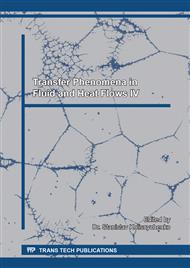[1]
A.S. Berman, Laminar flow in channels with porous walls, Journal of Applied Physics 24(9) (1953) 1232-1235.
DOI: 10.1063/1.1721476
Google Scholar
[2]
L.L. Debruge, L.S. Han, Heat transfer in a channel with a porous wall for turbine cooling application, J. Heat Transfer Trans. ASME 94 (1972) 385–390.
DOI: 10.1115/1.3449956
Google Scholar
[3]
M. Goto, S. Uchida, Unsteady flows in a semi-infinite expanding pipe with injection through wall, Trans Jpn Soc Aeronaut Space Sci. 33 (1990) 14–27.
Google Scholar
[4]
S. Dinarvand, M.M. Rashidi, A reliable treatment of Homotopy analysis method for two-dimensional viscous flow in a rectangular domain bounded by two moving porous walls, Nonlinear analysis: Real world applications 11 (3) (2010) 1502-1512.
DOI: 10.1016/j.nonrwa.2009.03.006
Google Scholar
[5]
P. K. Muhuri, Effect of rotation on unsteady hydromagnetic Couette flow, J. Phys. Soc. Jpn. 18 (1963) 1671.
Google Scholar
[6]
A.K. Singh, Stokes problem for a porous vertical plate with heat sinks by finite difference method, Astrophys. Space Sci. 103 (1984) 241–248.
DOI: 10.1007/bf00653740
Google Scholar
[7]
E.C. Dauenhauer, J. Majdalani, Unsteady flows in semi-infinite expanding channels with wall injection, AIAA paper (1999) 3499-3523.
DOI: 10.2514/6.1999-3523
Google Scholar
[8]
J. Majdalani, C. Zhou, Moderate-to-large injection and suction driven channel flows with expanding or contracting walls, ZAMM Z. Angew. Math. Mech. 83 (2003) 181-196.
DOI: 10.1002/zamm.200310018
Google Scholar
[9]
A. Ishak, J.H. Merkin, R. Nazar, I. Pop, Mixed convection boundary layer flow over a permeable vertical surface with prescribed wall heat flux, ZAMP 59 (2008) 100–123.
DOI: 10.1007/s00033-006-6082-7
Google Scholar
[10]
S.A. Al-Sanea, Mixed convection heat transfer along a continuously moving heated vertical plate with suction or injection, Int. J. Heat Mass Transfer 47 (2004) 1445–1465.
DOI: 10.1016/j.ijheatmasstransfer.2003.09.016
Google Scholar
[11]
S.U.S. Choi, Enhancing thermal conductivity of fluids with nanoparticles, In Proceedings of the 1995 ASME International Mechanical Engineering Congress and Exposition, 66(1995), San Francisco, USA, 99-105.
Google Scholar
[12]
S.K. Das, S.U.S. Choi, W. Yu, T. Pradeep, nanofluids: Science and Technology. Wiley, New York, (2007).
Google Scholar
[13]
P. Rana, R. Bhargava, Numerical study of heat transfer enhancement in mixed convection flow along a vertical plate with heat source/sink utilizing nanofluids, Commun. Nonlinear Sci. Numer. Simul. 16 (2011) 4318-4334.
DOI: 10.1016/j.cnsns.2011.03.014
Google Scholar
[14]
H. Xu, I. Pop, Fully developed mixed convection flow in a vertical channel filled with nanofluids, Int. Commun. Heat Mass Transfer 39 (8) (2012) 1086-1092.
DOI: 10.1016/j.icheatmasstransfer.2012.06.003
Google Scholar
[15]
M. Hatami, S.A.R. Sahebi, A. Majidian, M. Sheikholeslami, D. Jing, G. Domairry, Numerical analysis of nanofluid flow conveying nanoparticles through expanding and contracting gaps between permeable walls, J. Molecular Liquids 212 (2015) 785-791.
DOI: 10.1016/j.molliq.2015.10.040
Google Scholar
[16]
O.D. Makinde, Magneto-hydrodynamic stability of plane-Poiseuille flow using multi-deck asymptotic technique, Math. Comput. Model 37(3-4), (2003) 251–259.
DOI: 10.1016/s0895-7177(03)00004-9
Google Scholar
[17]
K.C. Cha'o, B.S. Chen, C.C. Liu, Entropy generation in mixed convection magnetohydrodynamic nanofluid flow in vertical channel, Int. J. of Heat and Mass Trans. 91 (2015) 1026-1033.
DOI: 10.1016/j.ijheatmasstransfer.2015.08.042
Google Scholar
[18]
S. Das, A.S. Banu, R.N. Jana, O.D. Makinde, Entropy analysis on MHD pseudo-plastic nanofluid flow through a vertical porous channel with convective heating, Alexandria Eng. J., 54 (2015) 325-337.
DOI: 10.1016/j.aej.2015.05.003
Google Scholar
[19]
S. Das, R.N. Jana, O.D. Makinde, Magnetohydrodynamic mixed convective slip flow over an inclined porous plate with viscous dissipation and Joule heating, Alexandria Eng. J., 54 (2015) 251-261.
DOI: 10.1016/j.aej.2015.03.003
Google Scholar
[20]
W.M. Kay, Convective heat and mass transfer, Mc-Graw Hill, New York, (1966).
Google Scholar
[21]
L.C. Woods, Thermodynamics of Fluid Systems, Oxford University Press, Oxford, UK, (1975).
Google Scholar
[22]
A. Bejan, Entropy-generation minimization, CRC Press, New York, (1996).
Google Scholar
[23]
H. Padé, Sur la représentation approchée d'une fonction pour des fractions rationnelles, Ann. Sci. École Norm. Sup. Suppl., 9 (1892) 1-93.
DOI: 10.24033/asens.378
Google Scholar
[24]
C. Hermite, Sur la généralisation des fractions continues algébriques, Annali di Mathematica Pura e Applicata, 21(2) (1893) 289-308.
DOI: 10.1007/bf02420446
Google Scholar
[25]
P.G. Drazin, Y. Tourigny, Numerically study of bifurcation by analytic continuation of a function defined by a power series, SIAM Journal of Applied Mathematics, 56 (1996) 1-18.
DOI: 10.1137/s0036139994272436
Google Scholar
[26]
M.A.H. Khan, High-Order Differential Approximants, Journal of Computational and Applied Mathematics, 149 (2002) 457-468.
DOI: 10.1016/s0377-0427(02)00561-7
Google Scholar
[27]
M. Hatami, M. Sheikholeslami, D.D. Ganji, Nanofluid flow and heat transfer in an asymmetric porous channel with expanding or contracting wall, J. Molecular Liquids, 195 (2014) 230-239.
DOI: 10.1016/j.molliq.2014.02.024
Google Scholar
[28]
M. Sheikholeslami, S. Abelman, and D.D. Ganji, Numerical simulation of MHD nanofluid flow and heat transfer considering viscous dissipation, Int. J. of Heat and Mass Trans. 79 (2014) 212-222.
DOI: 10.1016/j.ijheatmasstransfer.2014.08.004
Google Scholar


